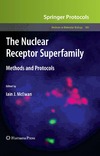Acting principally to control patterns of gene expression, nuclear receptors play vital roles during embryonic development and in the regulation of metabolic and reproductive functions in adult life, which proves this superfamily of ligand-activated transcription factors to be a crucial part of biological life. In The Nuclear Receptor Superfamily: Methods and Protocols, expert researchers describe a range of molecular, structural and cell biological techniques currently used to investigate the structure-function of nuclear receptors, together with experimental approaches that may lead to new therapeutic strategies for treating nuclear receptor-associated diseases. Written in the highly successful Methods in Molecular Biology™ series format, the chapters in this volume contain brief introductions to the topics, lists of the necessary materials and reagents, step-by-step, readily reproducible laboratory protocols, as well as notes from the experts to highlight tips on troubleshooting and avoiding known pitfalls.
Cutting-edge and easy to use, The Nuclear Receptor Superfamily: Methods and Protocols provides beneficial and time-saving guidance for all those undertaking research in this ever-growing field of study.
 |
|
О проекте
|
|
О проекте


